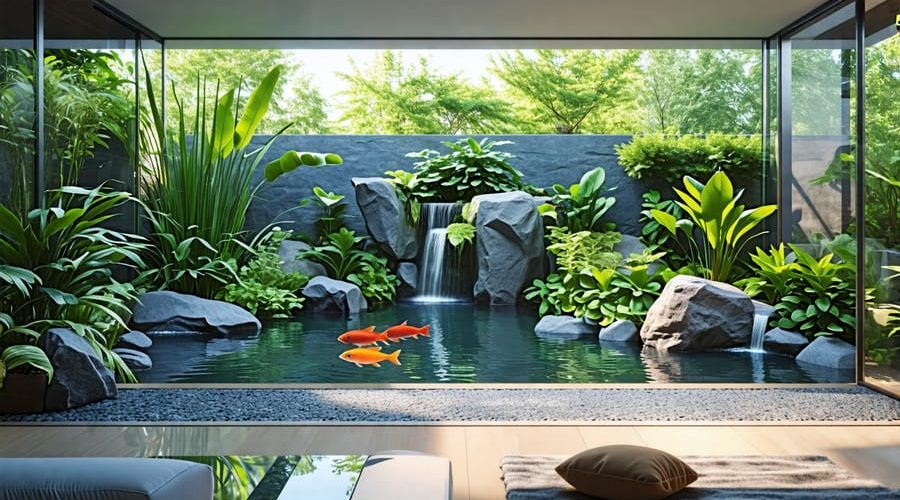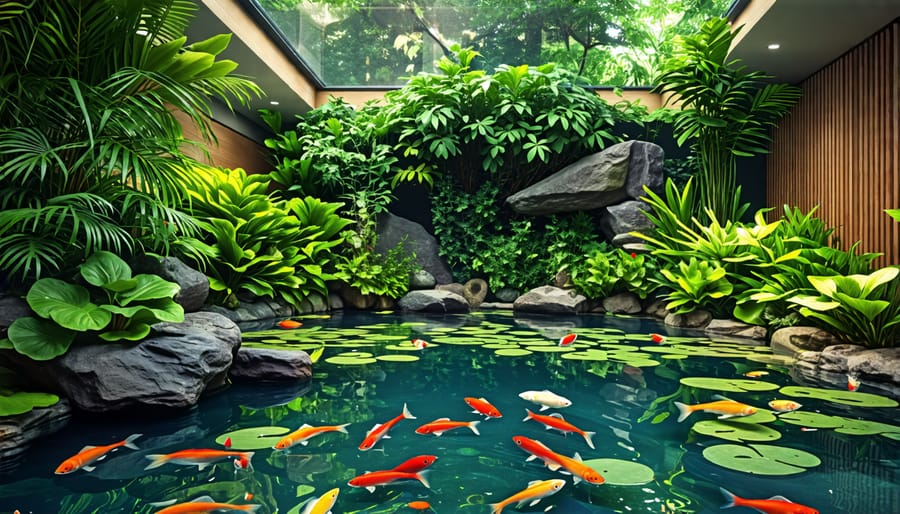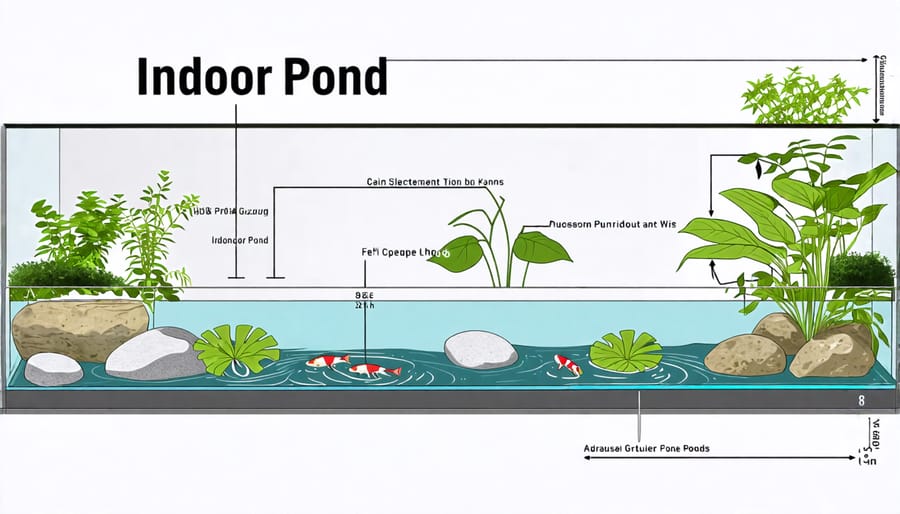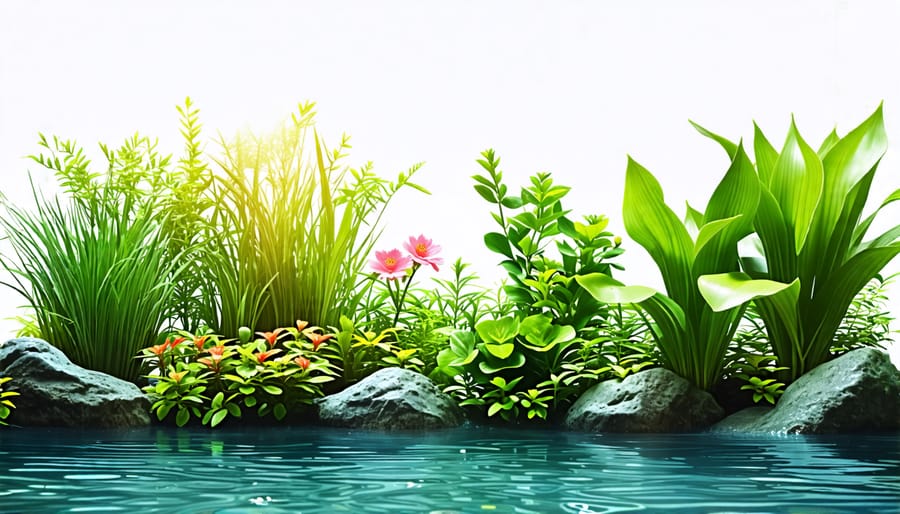
Bring the Serenity of a Pond Indoors: Your Modern Indoor Water Garden
Bring the serenity of a pond indoors with a modern twist. A well-designed indoor pond can transform any space into a tranquil oasis, blurring the lines between interior design and the beauty of nature. With creative elements like sleek water features, minimalist plantings, and contemporary materials, an indoor pond becomes a striking focal point that soothes the senses. Discover how to craft your own serene indoor water garden, from choosing the perfect location to selecting plants and fish that thrive in this unique environment. Embrace the trend of modern indoor ponds and create a living work of art that brings a touch of Zen to your everyday surroundings.
Designing Your Indoor Pond

Choosing the Right Location
When selecting the perfect spot for your modern indoor pond, consider factors like light, space, and accessibility. Natural light is ideal for plant growth, but avoid direct sunlight which can cause algae blooms. Ensure there’s enough space for the pond size you envision, plus room to move around it comfortably. Pick a location near electrical outlets for pumps and filters, and close to a water source for easy filling and maintenance. Avoid high-traffic areas where the pond could be disturbed or damaged. Consider the pond’s weight when filled and choose a sturdy floor or reinforce if needed. Visualize how the pond will fit into your interior design scheme – it should complement your style and create a focal point. Lastly, make sure the location allows for proper ventilation to prevent humidity build-up. Take your time deciding on the right spot – a well-placed indoor pond will bring years of enjoyment and tranquility to your home.
Determining Pond Size and Shape
When determining the size and shape of your indoor pond, consider the available space and the pond’s intended purpose. Measure the area where you plan to install the pond, taking into account any surrounding furniture or decor. A rectangular or square shape is often the most space-efficient, but you can also opt for an organic, free-form shape for a more natural look. As a general rule, aim for a pond that is at least 18 inches deep to accommodate aquatic plants and provide a stable environment for fish. For a small room, a tabletop pond around 2 feet wide and 3 feet long can create a lovely focal point. In a larger space, you might consider a built-in pond that’s 4 feet wide and 6 feet long or more. Remember to leave enough room around the pond for maintenance access and to showcase your water feature.
Selecting Materials
When selecting materials for your modern indoor pond, there are several key components to consider. For the pond liner, you have options like flexible PVC, EPDM rubber, or preformed plastic shells. Each has pros and cons in terms of durability, customization, and ease of installation.
Next, choose a suitable pump to circulate and aerate the water. Submersible pumps are a popular choice for their quiet operation and hidden placement. Ensure the pump’s flow rate matches your pond’s volume for optimal circulation.
Filtration is crucial for maintaining clear, healthy water. Pond filters come in various types, such as mechanical, biological, and UV clarifiers. Select a filter rated for your pond’s size and fish population, if applicable.
Don’t forget about pond lighting to enhance ambiance and showcase your water feature. LED spotlights or underwater lights add a captivating glow. For a natural touch, consider adding aquatic plants like water lilies, lotus, or marginal plants.
Other accessories to consider include water treatments to balance pH and prevent algae, decorative elements like rocks or driftwood, and perhaps a small fountain or waterfall for soothing sounds. With careful material selection, your indoor pond will be a stunning and tranquil addition to your home.

Building the Pond
Preparing the Area
Before setting up your indoor pond, prepare the designated area. Choose a level, stable surface that can support the weight of the filled pond. Lay down a waterproof liner or mat to protect your flooring from potential leaks or spills. Ensure the location has access to electrical outlets if you plan to install a pump, filter, or lighting. Consider the room’s humidity levels and ventilation, as the pond may increase moisture in the air. Clear the surrounding space of any obstructions or hazards, allowing ample room for maintenance and enjoyment of your tranquil indoor oasis.
Installing the Pond
Once you have all the necessary components, it’s time to set up your modern indoor pond. Start by selecting a level, sturdy surface that can support the weight of the pond and water. Place a protective liner or mat underneath to catch any spills or leaks. Assemble the pond structure according to the manufacturer’s instructions, ensuring all parts are securely connected. If using a preformed pond, carefully place it in the desired location. For a custom design, build the frame and line it with a heavy-duty pond liner, smoothing out any wrinkles or folds.
Install the filtration system, following the product guidelines. Position the pump and connect the tubing, making sure the flow rate is appropriate for your pond size. Incorporate any additional features, such as waterfalls, fountains, or lighting, at this stage. Test the equipment to ensure proper functioning and make any necessary adjustments.
Rinse the substrate thoroughly to remove dust and debris. Gently add it to the bottom of the pond, creating a natural-looking base. Arrange rocks, driftwood, and other decorative elements to enhance the aesthetic appeal. Be mindful of the overall composition and ensure the items are stable and secure.
Gradually fill the pond with dechlorinated water, monitoring for any leaks or issues. Once filled, let the water circulate through the filtration system for several hours to establish a healthy environment. Test the water parameters and make any necessary adjustments before introducing plants or fish.
When selecting aquatic plants, consider their growth habits, lighting requirements, and compatibility with your pond setup. Carefully rinse the plants to remove any dirt or pests, and gently place them in the designated areas. Anchor them securely to prevent floating or uprooting.
If adding fish, choose species well-suited to the size and conditions of your indoor pond. Acclimate them slowly to the new environment by floating their bag in the pond water for about 15 minutes before releasing them. Monitor their behavior and health closely during the first few days.
With patience and attention to detail, your modern indoor pond will soon become a thriving, tranquil oasis in your home. Regular maintenance, including water changes, filter cleaning, and plant care, will keep your pond looking its best for years to come.
Adding Plants and Fish
Choosing the Right Plants
Selecting the right plants is crucial for creating a thriving indoor pond ecosystem. There are many beautiful aquatic plants that can add color, texture, and oxygenation to your water feature. Some popular options include water lilies, which come in a range of colors and sizes to suit any pond. Floating plants like water lettuce and water hyacinth have attractive foliage and help absorb excess nutrients. Submerged plants such as anacharis and hornwort provide hiding spots for fish and keep the water clear.
When choosing plants, consider their lighting and temperature needs, as well as their growth habits. Some may require more maintenance like pruning to prevent overgrowth. You’ll also want to avoid invasive species that can take over your pond. Aim for a diverse mix of plant types to create a balanced environment.
For a more productive setup, consider incorporating an aquaponics system that utilizes fish waste to nourish your plants. This sustainable method can yield fresh herbs and veggies right in your home. With the right plant selection and care, your indoor pond will become a lush and thriving centerpiece.

Stocking Your Pond with Fish
When stocking your indoor pond with fish, opt for species that are well-suited to smaller environments and adapt easily to indoor conditions. White Cloud Mountain Minnows are a popular choice, as they are hardy, peaceful, and thrive in a variety of water temperatures. Zebra Danios are another excellent option, known for their active swimming and vibrant striped patterns. For a pop of color, consider adding a few fancy guppies or neon tetras, which come in a range of bright hues and add visual interest to your pond. If you prefer a more laid-back fish, White Cloud Minnows or small loaches like Kuhli Loaches are ideal, as they tend to be calm and undemanding. When selecting fish, be mindful of their adult size, social needs, and compatibility with other species to ensure a harmonious and thriving indoor pond community. Always research the specific requirements of each fish species, including their preferred water parameters, diet, and any special care considerations, to create a healthy and balanced ecosystem within your modern indoor pond.
Maintaining Your Indoor Pond
Maintaining a healthy and attractive indoor pond requires regular care and attention. One of the most important tasks is to monitor water quality, testing pH levels and ammonia weekly and making adjustments as needed. Partial water changes every few weeks can help refresh the ecosystem.
Removing debris like fallen leaves is also key – use a fine net to skim the surface. Prune any overgrown plants to prevent them from taking over. If algae blooms occur, manually remove what you can and consider adding beneficial bacteria to outcompete the algae for nutrients.
Filters and pumps are the heart of your pond, so clean or replace them on schedule per the manufacturer’s guidelines. Occasionally siphon out accumulated sludge and waste from the bottom. With underwater lighting, wipe any buildup off the lens covers to keep your pond well-illuminated.
Feeding fish sparingly and providing them a varied diet supports their health. Remove and treat any sick fish in a separate tank to avoid spreading disease. By staying on top of these essential pond maintenance tasks, your indoor aquatic garden will continue to thrive as a beautiful living centerpiece in your home.
